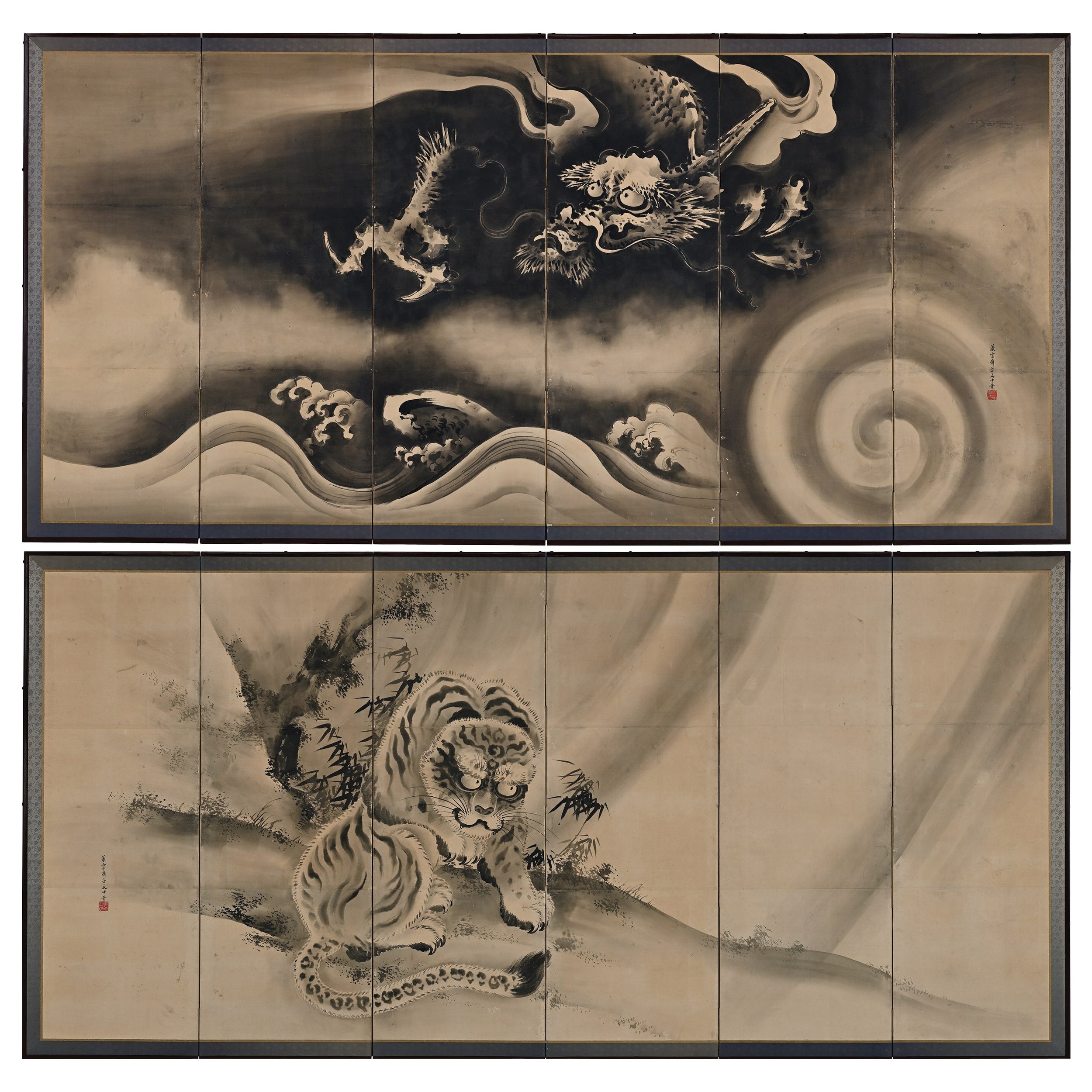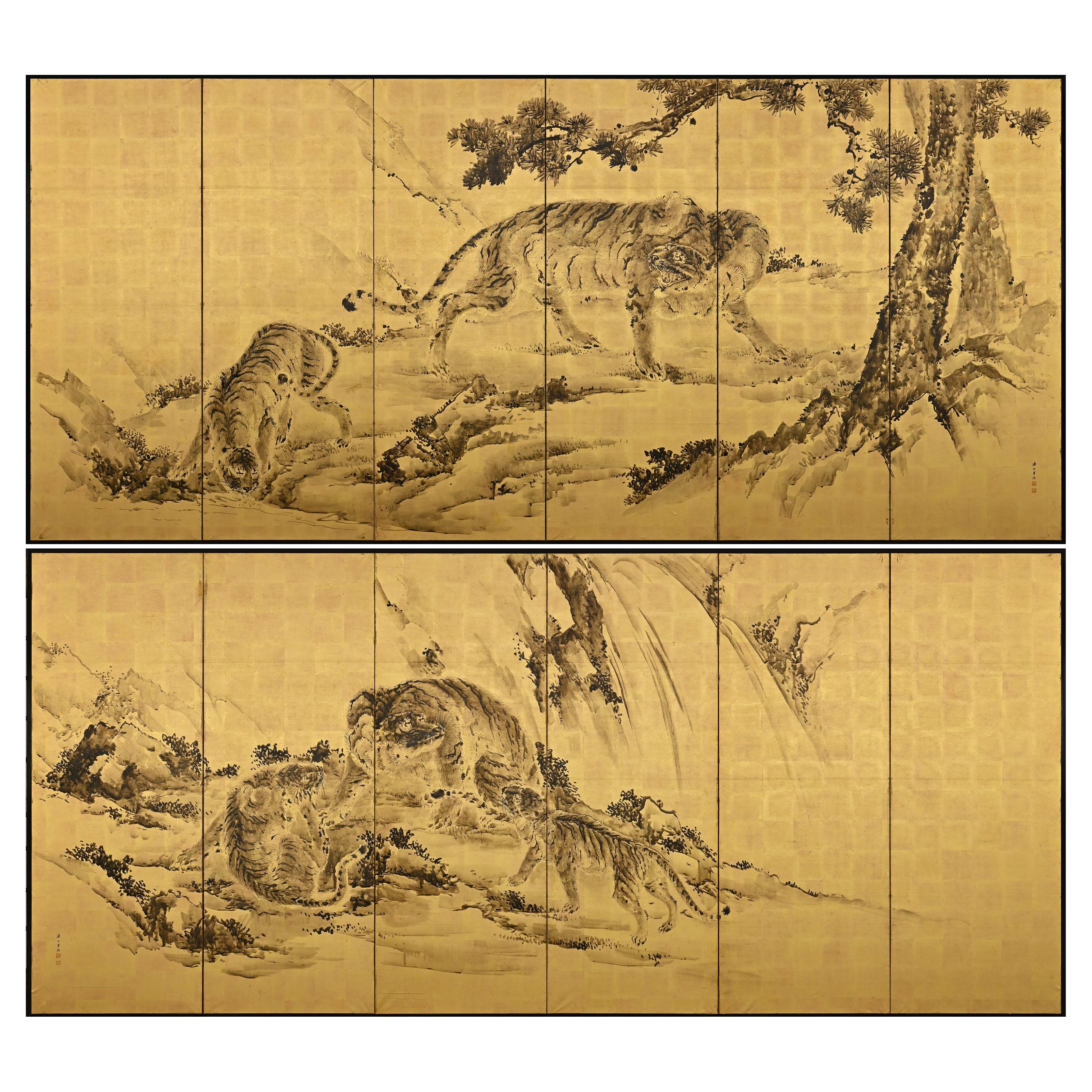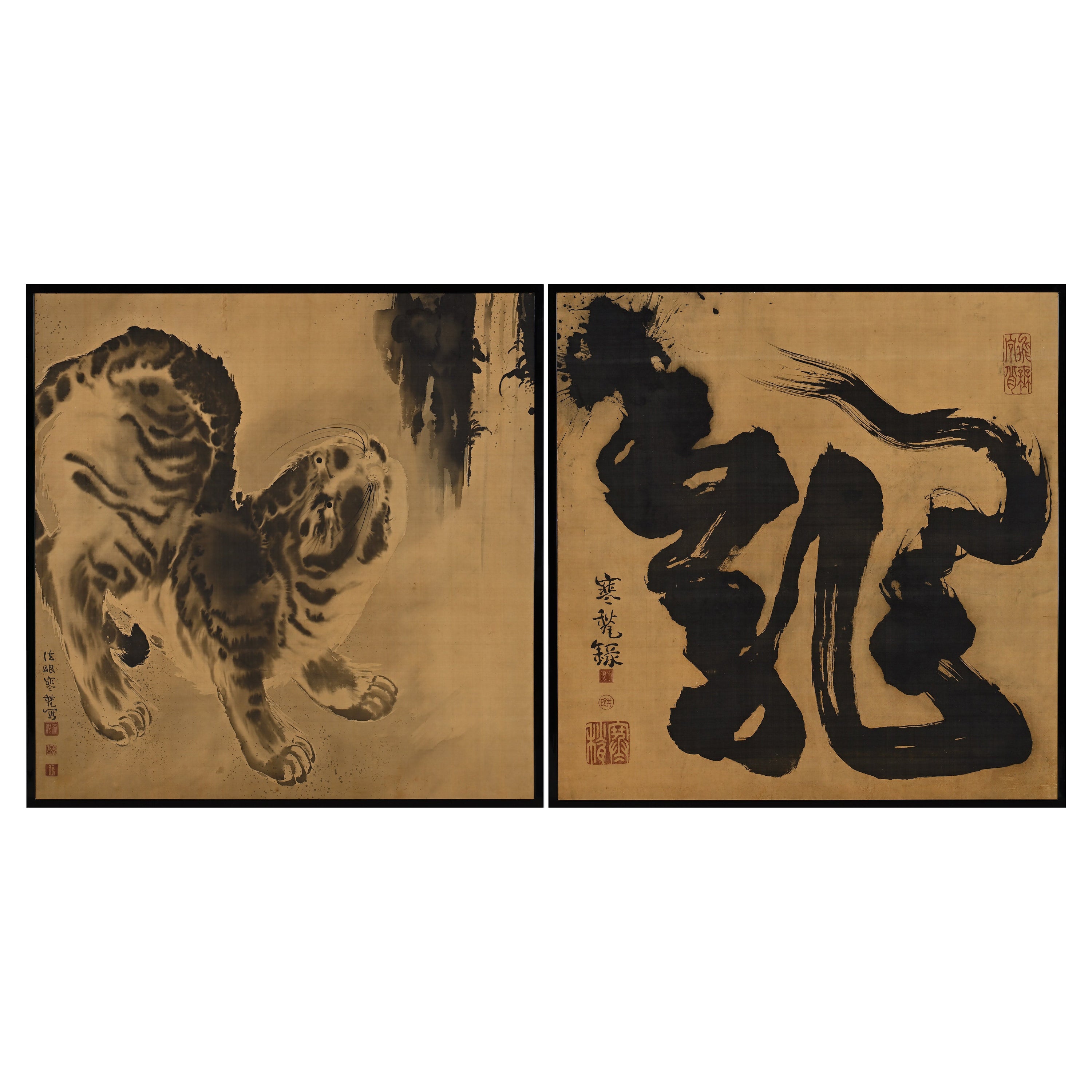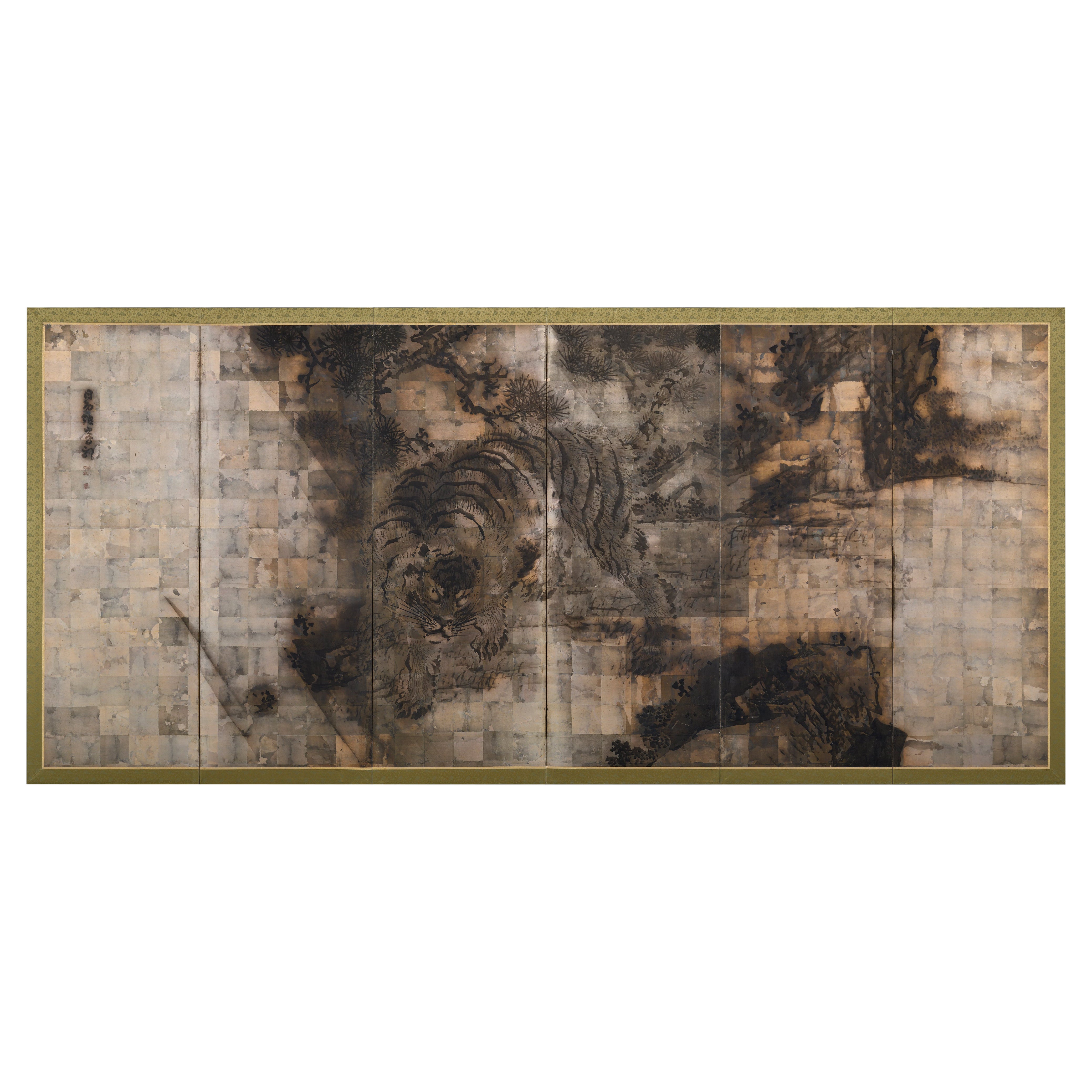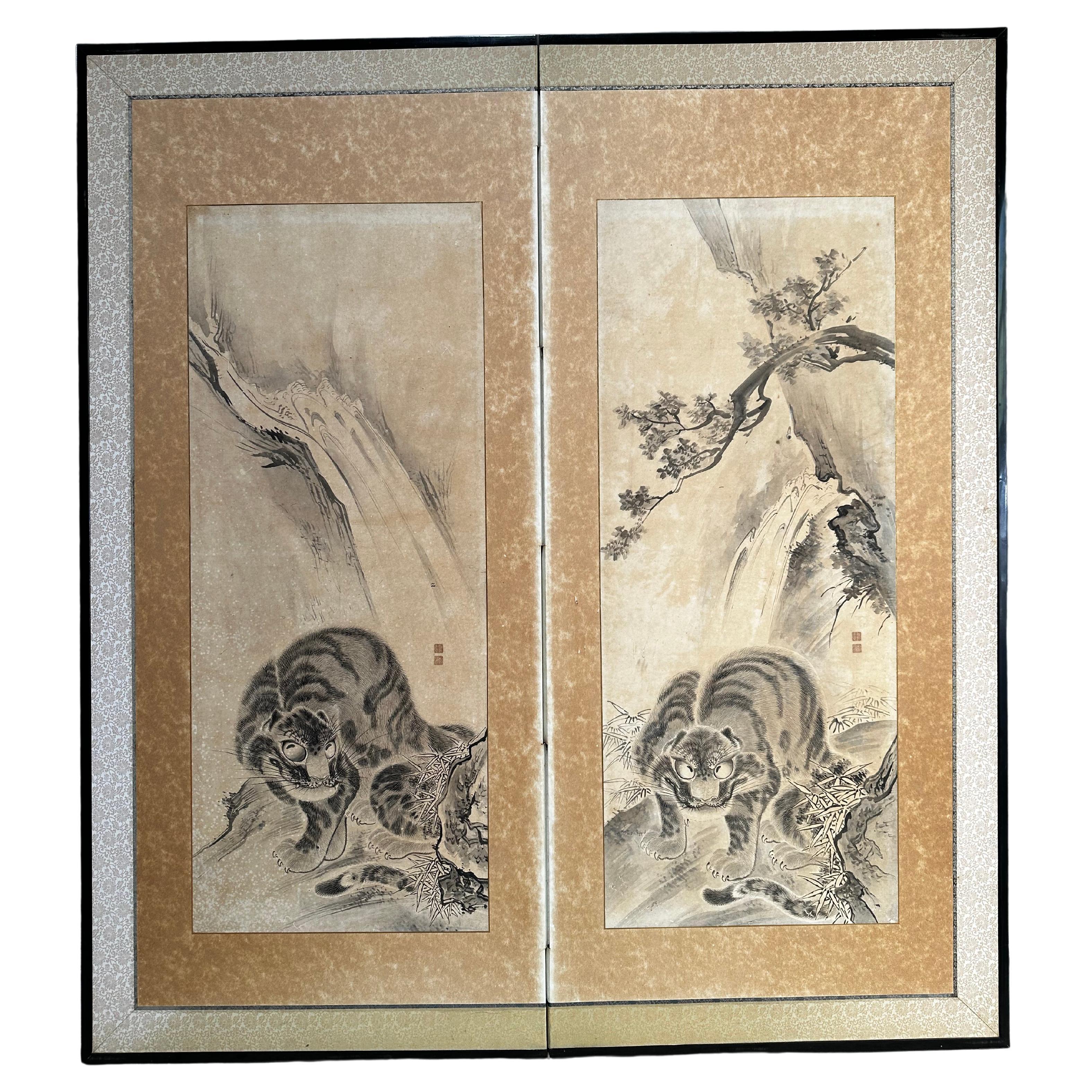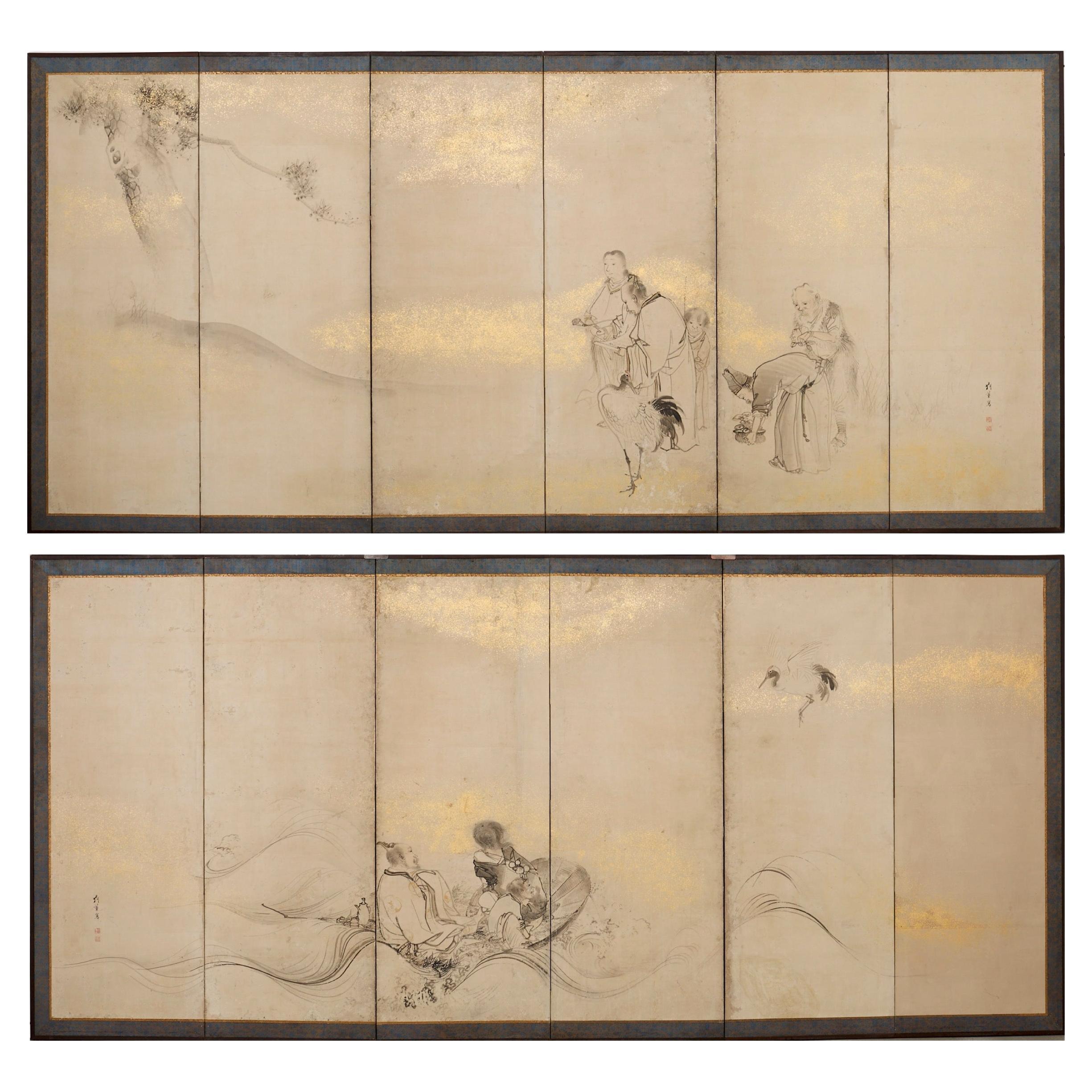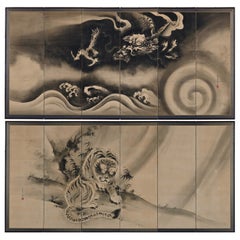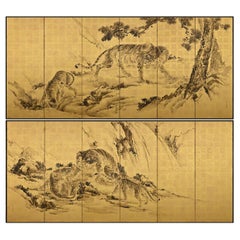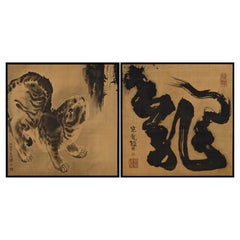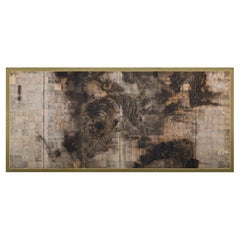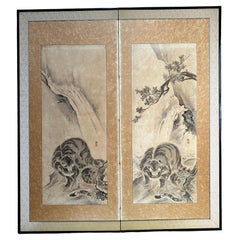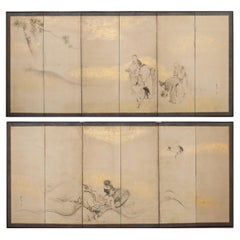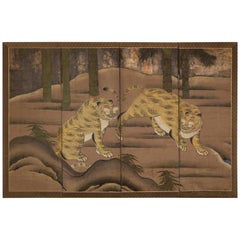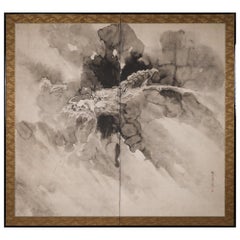Items Similar to 17th Century Japanese Screen Pair. Tiger & Dragon by Kaiho Yusetsu
Want more images or videos?
Request additional images or videos from the seller
1 of 11
17th Century Japanese Screen Pair. Tiger & Dragon by Kaiho Yusetsu
$78,000per set
£59,227.25per set
€67,730.78per set
CA$108,977.31per set
A$121,206.56per set
CHF 63,290.30per set
MX$1,474,954.88per set
NOK 808,313.69per set
SEK 758,055.64per set
DKK 505,500.77per set
Shipping
Retrieving quote...The 1stDibs Promise:
Authenticity Guarantee,
Money-Back Guarantee,
24-Hour Cancellation
About the Item
Kaiho Yusetsu (1598-1677)
Tiger and Dragon
Early Edo Period, Circa 1650
A Pair of Six-fold Japanese Screens. Ink and slight color on paper.
Dimensions:
Each screen: H. 171 cm x W. 380 cm (67.5’’ x 149.5’’)
In this pair of early Edo period Japanese screens a group of tigers prowl in a bamboo grove whipped with fierce wind, while a dragon claws through clouds and mist. The dragon embodies elemental qualities - looming out of the mist, the coils of its body disappearing in the clouds. The dragon is calling for rain, symbolizing spring which is considered the fountain of life. On the other side, the tigers calls for the wind, symbolizing autumn which is considered the end of life. Tigers were familiar motifs within Japanese art from ancient times though the animals were imaginary to the people in the 17th century. While dragons and tigers are usually associated as sacred and ferocious, in this painting, both animals have rather amusing expressions. The tigers appear to glare at the dragon with cat-like eyes, and the look on the swirling dragon’s face appears almost affectionate - lending a playful flair to an otherwise magnificent theme.
The tiger and dragon are cosmological symbols of the balancing forces in the world. Screens such as this were originally meant to express the fluctuating nature of the world. For Japanese in the early Edo period, they likely suggested the powers of the cosmos. In Japan the tiger and dragon motif was originally absorbed into the circles of Zen monasteries before spreading into the secular world. The theme especially appealed to the military classes with the Kano school, the official painters to the Shogun and the samurai, being the leading contributors. The painter of this pair of screens, Kaiho Yusetsu (1598-1677), was closely patronized by the third Shogun Tokugawa Iemitsu. In his later years he worked with Kano school artists to produce large scale paintings on sliding doors and interior walls. The most notable of these were the waiting rooms of the Kyoto Imperial Palace and the residence for court ladies. His masterpiece, Dragon and Clouds, was painted at Rinsho-in in 1634. Rinsho-in was constructed by the Tokugawa Iemitsu in memory of his foster mother Lady Kasuga. His father, Kaiho Yusho, was arguably the most famous painter of dragons in Japanese history. Though he undoubtedly painted them, none of his tigers remain.
- Dimensions:Height: 67.5 in (171.45 cm)Width: 149.5 in (379.73 cm)Depth: 0.75 in (1.91 cm)
- Sold As:Set of 2
- Style:Edo (Of the Period)
- Materials and Techniques:
- Place of Origin:
- Period:Mid-17th Century
- Date of Manufacture:circa 1650
- Condition:Repaired: The screens have recently been completely restored and remounted in Kyoto utilizing traditional craftsmen and techniques. Refinished. Wear consistent with age and use.
- Seller Location:Kyoto, JP
- Reference Number:1stDibs: LU2472332244172
About the Seller
5.0
Recognized Seller
These prestigious sellers are industry leaders and represent the highest echelon for item quality and design.
Established in 2001
1stDibs seller since 2016
70 sales on 1stDibs
Typical response time: 6 hours
- ShippingRetrieving quote...Shipping from: Kyoto, Japan
- Return Policy
Authenticity Guarantee
In the unlikely event there’s an issue with an item’s authenticity, contact us within 1 year for a full refund. DetailsMoney-Back Guarantee
If your item is not as described, is damaged in transit, or does not arrive, contact us within 7 days for a full refund. Details24-Hour Cancellation
You have a 24-hour grace period in which to reconsider your purchase, with no questions asked.Vetted Professional Sellers
Our world-class sellers must adhere to strict standards for service and quality, maintaining the integrity of our listings.Price-Match Guarantee
If you find that a seller listed the same item for a lower price elsewhere, we’ll match it.Trusted Global Delivery
Our best-in-class carrier network provides specialized shipping options worldwide, including custom delivery.More From This Seller
View All19th Century Japanese Screen Pair. Tiger & Dragon by Tani Bunchu.
Located in Kyoto, JP
Tani Bunchu (1823-1876)
Tiger and Dragon
A pair of six-panel Japanese screens. Ink on paper.
In this grand pair of Japanese Ryuko-zu screens the tiger crouches low to the ground, ...
Category
Antique Mid-19th Century Japanese Edo Paintings and Screens
Materials
Wood, Paper
Japanese Screen Pair, Tigers by Kishi Renzan, Late Edo Period
Located in Kyoto, JP
Kishi Renzan (1804-1859)
Tigers
Pair of six-panel Japanese screens.
Ink and gold-leaf on paper.
In this monochromatic pair of six-fold Japanese screens painted on gold-leaf, Kishi Renzan has created a breathtaking composition of a family of tigers. The screens are filled with a sense of drama which is conveyed by both the subject matter and the wet, expressive brushwork. The running mountain stream and the towering waterfall allude to refreshment during the summer months and we feel the tiger families familiarity and security within their environment. Renzan’s master, Kishi Ganku...
Category
Antique Mid-19th Century Asian Edo Paintings and Screens
Materials
Gold Leaf
19th Century Japanese Paintings. Zenga Tiger and Dragon by Inoue Kanshu.
Located in Kyoto, JP
Inoue Kanshu (1807-1880)
Zenga Tiger and Dragon
19th century
Pair of framed Japanese paintings. Ink on silk.
Dimensions (each): W. 114 cm x H. 115 cm (45” x 45”)
Presented here ...
Category
Antique Mid-19th Century Japanese Meiji Paintings and Screens
Materials
Silk
Edo period Japanese Screen. Tiger and Pine by Kishi Ganku.
Located in Kyoto, JP
Kishi Ganku (1749/1756-1838)
Tiger and Pine
A six-panel Japanese Screen. Ink on silver leaf.
The central focus of this Japanese screen is a large tiger, emerging from shadow, crou...
Category
Antique Late 18th Century Japanese Edo Paintings and Screens
Materials
Silver Leaf
Japanese Screen Painting, Circa 1700 'Tales of Ise' by Tosa Mitsusuke
By Tosa Mitsusuke 1
Located in Kyoto, JP
A six-fold Japanese screen by Tosa Mitsusuke (1675-1710), Japan 17th-18th century, Edo period.
The signature reads Shoroku-i ge Tosa sa Konoe Shogen Mit...
Category
Antique Late 17th Century Japanese Edo Paintings and Screens
Materials
Gold Leaf
Mid 19th Century Japanese Screen Pair. Flowers & Birds of the Four Seasons.
Located in Kyoto, JP
Shioka Sorin (1781-1850)
Flowers & Birds of the Four Seasons
Pair of six-panel Japanese Screens. Ink, gofun and pigments on silk.
Dimensions (each screen): H. 91.5cm x W. 285cm (3...
Category
Antique Mid-19th Century Japanese Edo Paintings and Screens
Materials
Silk
You May Also Like
18th Century Nagasaki School Tiger Screen
Located in Fukuoka, JP
18th Century Nagasaki School Tiger Screen
Period: Edo
Size: 165 x 172 cm (65 x 67.7 inches)
SKU: PTA69
This exceptional 18th-century screen from the Edo...
Category
Antique Early 18th Century Japanese Edo Paintings and Screens
Materials
Wood, Paper
Pair of 18th Century Japanese Edo Screens of Chinese Immortals
Located in Rio Vista, CA
Mesmerizing pair of late 18th/early 19th century Japanese Edo period byobu screens by Shibata Gito (Japanese 1780-1819). The paintings depict Chinese immortals in a dreamy landscape....
Category
Antique 18th Century Japanese Edo Paintings and Screens
Materials
Silk, Wood, Paper
Japanese Four Panel Screen: Two Tigers
Located in Hudson, NY
Two tigers exchanging amorous glances. Kano School painting.
Category
Antique 18th Century Japanese Paintings and Screens
Materials
Paper
Japanese Two Panel Screen Dragon in the Mist
Located in Hudson, NY
Ink (Sumi) on paper. Signature and Seal read: Kishi Ganku It is backed with paper covered in gold and silver flake. Kishi Ganku (1749 or 1756-1839) was the...
Category
Antique Early 19th Century Japanese Edo Paintings and Screens
Materials
Wood, Paper
Pair of Japanese Edo/Tokugawa Screens Tale of Heiki
Located in Rio Vista, CA
Monumental pair of late 18th century Japanese Edo/Tokugawa period byobu screens depicting the battles between Taira and Minamoto. The screens have six panels each with individual sce...
Category
Antique 19th Century Japanese Edo Paintings and Screens
Materials
Brass, Gold Leaf
Pair of Antique Japanese Paintings of Karashishi, Edo Period, 18th Century
Located in Prahran, Victoria
A rare pair of antique Japanese Karashishi paintings in a landscape of rocks and peony flowers on gold leaf ground in fine handmade frames, Edo period, early 18th century. The Karash...
Category
Antique Early 18th Century Japanese Edo Paintings and Screens
Materials
Gold Leaf
More Ways To Browse
Mid Century Screen
Japanese Dragon
Antique Japanese Dragon
Asian Tiger
Mid Century Folding Screen
Asian Tiger Art
Japanese Wall Screen
Japanese Zen Furniture
Dragon Silk
Hand Painted Tiger
Pair Of Japanese Paintings
Japanese Folding Screen Screen
Japanese Screen Bamboo
Bamboo Screen Mid Century
Used Screen Doors
Japanese Edo Period Screens
Japanese Folding Screen Art
Antique Tiger Wood
